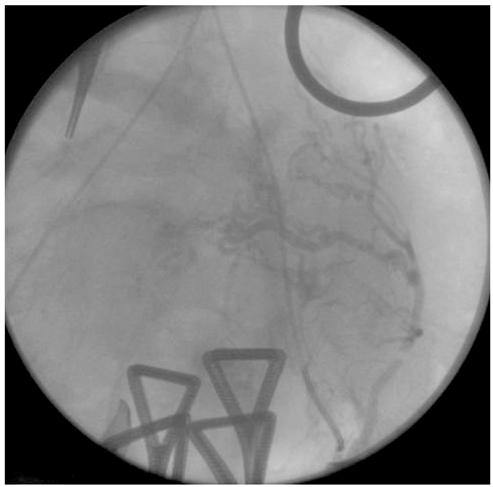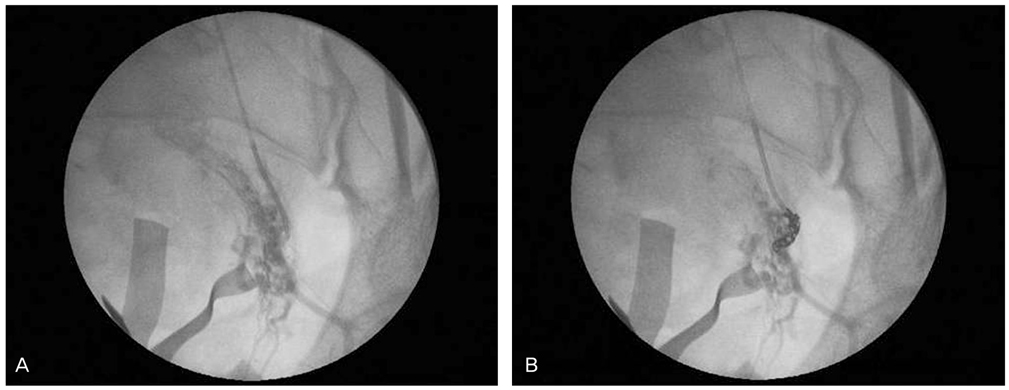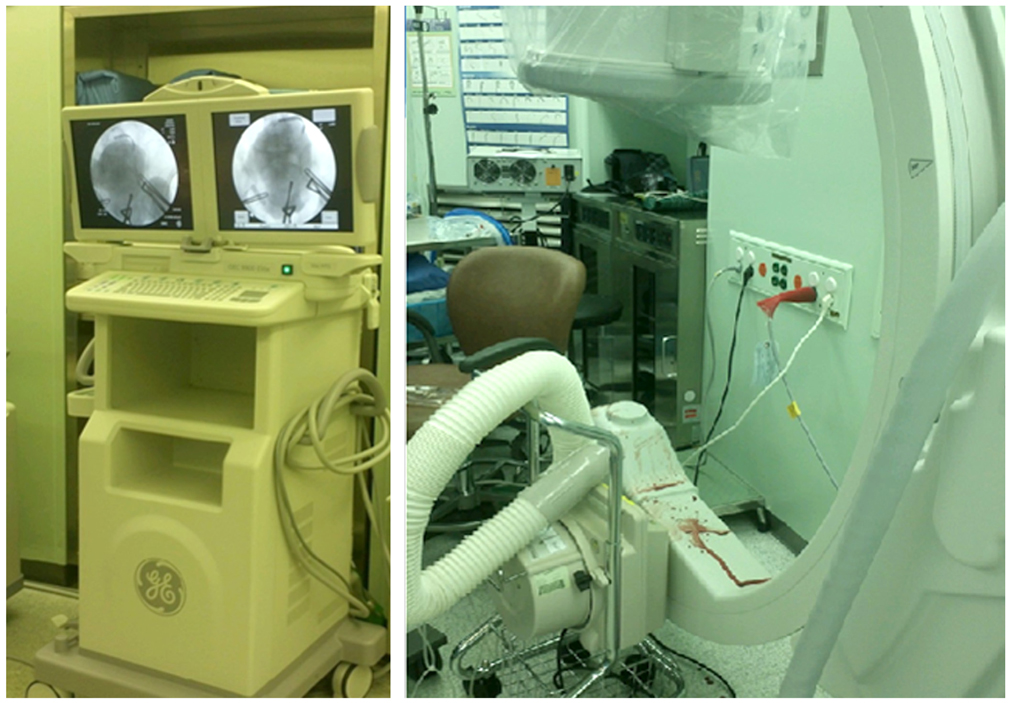Obstet Gynecol Sci.
2013 Jan;56(1):45-49. 10.5468/OGS.2013.56.1.45.
Intraoperative uterine artery embolization without fetal radiation exposure in patients with placenta previa totalis: Two case reports
- Affiliations
-
- 1Department of Obstetrics and Gynecology, Seoul National University College of Medicine, Seoul, Korea.
- 2Department of Obstetrics and Gynecology, Seoul National University Bundang Hospital, Seoul National University College of Medicine, Seongnam, Korea. hjsobgy@gmail.com
- KMID: 1857186
- DOI: http://doi.org/10.5468/OGS.2013.56.1.45
Abstract
- Embolization of the uterine arteries is a valuable method for controlling postpartum hemorrhage. There have been recent attempts to apply this tool as a means of controlling bleeding during Cesarean section, especially in patients with placenta previa. However, the benefits are controversial due to lack of randomized controlled studies, no evidence of significant improved outcomes, and potential harm including radiation exposure. This paper includes two case reports of intraoperative uterine artery embolization without fetal radiation exposure in patients with placenta previa totalis.
MeSH Terms
Figure
Reference
-
1. Ossola MW, Somigliana E, Mauro M, Acaia B, Benaglia L, Fedele L. Risk factors for emergency postpartum hysterectomy: the neglected role of previous surgically induced abortions. Acta Obstet Gynecol Scand. 2011. 90:1450–1453.2. Crane JM, Van den Hof MC, Dodds L, Armson BA, Liston R. Maternal complications with placenta previa. Am J Perinatol. 2000. 17:101–105.3. Chauleur C, Fanget C, Tourne G, Levy R, Larchez C, Seffert P. Serious primary post-partum hemorrhage, arterial embolization and future fertility: a retrospective study of 46 cases. Hum Reprod. 2008. 23:1553–1559.4. Dilauro MD, Dason S, Athreya S. Prophylactic balloon occlusion of internal iliac arteries in women with placenta accreta: literature review and analysis. Clin Radiol. 2012. 67:515–520.5. Shellhaas CS, Gilbert S, Landon MB, Varner MW, Leveno KJ, Hauth JC, et al. The frequency and complication rates of hysterectomy accompanying Cesarean delivery. Obstet Gynecol. 2009. 114:224–229.6. Rossi AC, Lee RH, Chmait RH. Emergency postpartum hysterectomy for uncontrolled postpartum bleeding: a systematic review. Obstet Gynecol. 2010. 115:637–644.7. Yu PC, Ou HY, Tsang LL, Kung FT, Hsu TY, Cheng YF. Prophylactic intraoperative uterine artery embolization to control hemorrhage in abnormal placentation during late gestation. Fertil Steril. 2009. 91:1951–1955.8. Levine AB, Kuhlman K, Bonn J. Placenta accreta: comparison of cases managed with and without pelvic artery balloon catheters. J Matern Fetal Med. 1999. 8:173–176.9. Yi KW, Oh MJ, Seo TS, So KA, Paek YC, Kim HJ. Prophylactic hypogastric artery ballooning in a patient with complete placenta previa and increta. J Korean Med Sci. 2010. 25:651–655.10. Bodner LJ, Nosher JL, Gribbin C, Siegel RL, Beale S, Scorza W. Balloon-assisted occlusion of the internal iliac arteries in patients with placenta accreta/percreta. Cardiovasc Intervent Radiol. 2006. 29:354–361.11. Cousins C. Medical radiation and pregnancy. Health Phys. 2008. 95:551–553.
- Full Text Links
- Actions
-
Cited
- CITED
-
- Close
- Share
- Similar articles
-
- Anesthetic management of a parturient with placenta previa totalis undergoing preventive uterine artery embolization before placental expulsion during cesarean delivery: a case report
- Placenta previa totalis and previous cesarean section
- A Case of Placenta Percreta Involving the Urinary Bladder
- Management of massive hemorrhage in pregnant women with placenta previa
- A Case of Pulmonary Thromboembolism during Ceaserian Section of Placenta Previa Totalis: A case report




